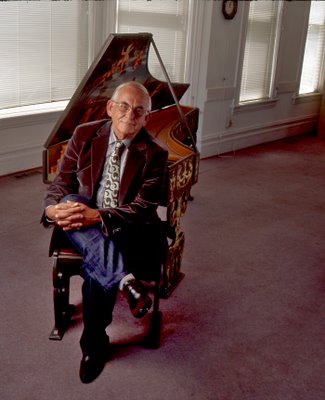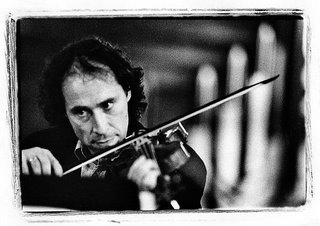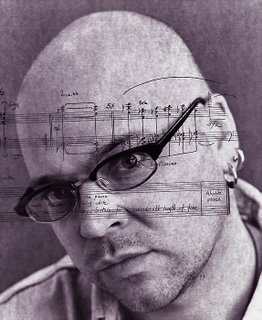José Verstappen, below left, the Executive Director of Early Music Vancouver has patiently nurtured a relationship with great baroque orchestras of the world and virtuoso performers while balancing it all by hiring and featuring local orchestras. It is because of this that he is giving Vancouver (and me!) the oportunity to listen to all six of Bach's Brandenburg Concertos played by one of the finest Baroque ensembles of the world, The Academy of Ancient Music. This is not an event that happens with any kind of frequency.

I don't as yet have the ambition of sitting down to watch Richard Wagner's Der Ring des Nibelungen. As my Argentine nephews would so crassly point out, "You would not want the line between your buttocks to disappear." My musical ambitions to listen to complete or rare pieces of live music are slightly more restrained but probably less likely to occur in one's lifetime.
Yet, 2008 and 2009, so far, have been excellent years for fulfilling these musical rights of passage. That they have happened or will happen in Vancouver is most extraordinary. I have my doubts that Toronto or Montreal and perhaps not even New York City could have mounted these three performances in a 5 month period. Consider:
November 29, 2008: Olivier Messiaen’s The Quartet for the End of Time performed by The Turning Point Ensemble.
February 15, 2009: Erik Satie’s Relâche performed by the Turning Point Ensemble.
March 11 (today), 2009 Bach’s The Six Brandenburg Concertos performed by The Ancient Academy of Music
In Mexico City I was lucky enough to listen to 5 of the 6 Brandenburg Concertos. The second one, in F major, was not performed as the impossibly difficult valveless trumpet, the clarino, part is even more difficult to play in Mexico City's rarified air.
Tonight I will be sitting with my friend Graham Walker at the Orpheum and we will delight at listening to all 6. The Orpheum's plush seats will keep the parting of that which we sit with intact.
Without any other factors to consider it would be enough for me to attend the concert knowing that The Academy of Ancient Music (its modern incarnation started when it was founded by Christopher Hogwood in 1973) had its beginnings in 1726 and that some of its concerts featured the then new music of Handel and his physical presence!
Furthermore after having gone to numerous Early Music Vancouver concerts in the past that featured harpsichordist Richard Egarr (now musical director of the Academy) I would not miss this concert knowing that this unassuming virtuso with a penchant for loud ties and socks will be in town again to lead in a performance of these works by a small ensemble of solo instruments. Scholars believe that the Brandenburgs were never intended for large orchestras.
When I sit with Graham Walker tonight my mother will be with me in spirit. She always told me that her desert island music could only be the complete Brandenburgs. "I would not need to listen to anything else. I would never grow bored of them."
But there are other interesting facts about the Brandenburgs, named after the Margrave of Brandenburg, who commissioned Bach to compose them. Bach was too busy to compose from scratch. So he assembled his more-or-less recent work and sent it off with the appropriate humble dedication. Musical gossip loves tales of genius unappreciated, so it has often been told that the Margrave didn't think much of the package and never bothered to have any of it performed. Perhaps the real reason that these concerti were not performed is that they were much too difficult for the Margrave's orchestra to play. They are written in the Italian style, three movements: fast, slow, fast, except for Brandenburg No 1 which has four. And if you are at the concert tonight listen to that trumpet in the Number 2 Concerto in F Major to find out what difficult and fast is.
My two favourites are the one with the high-pitched instruments, Number 2 and Number 5 in D Major, which features an extraordinary harpsichord cadenza where the player is given room to improvise. I will be sure to take my binoculars to check on Egarr's socks.
A few months back I listened to the Pacific Baroque Orchestra play Bach's Concerto in D Minor for Two Violins. I noticed some similarity to the Brandenburgs. So I asked an expert, violinist Marc Destrubé, below, centre, for an explanation. This was his answer:

I would say that what all of Bach's concertos have in common is a particular style (inspired very much from Italian models, Vivaldi in particular). The so-called 'joy-motive' I've referred to in rehearsal was first remarked on by Albert Schweitzer I believe, a three note figure which you hear repeated 5 times at the beginning of the Third Brandenburg concerto, for example. Once you've identified it, then you'll notice it all over the place (like noticing all the Audis on the road if you own one yourself), including in the opening of the last movement of the double violin concerto (although in this case it doesn't stop and repeat but is propelled forward); same with the opening movement of the E Major violin partita (No. 3). Which is also an organ prelude, and also used in a cantata.
In fact, once you start to explore this stuff in Bach you quickly get overwhelmed by the wonder of it all, particularly in the cantatas, virtually every page of which contains some magic stroke of musical symbolism (eg. the one alto aria in Tuesday's cantata concert has a transformation of tempo - from a leisurely minuet to a quick Allegro -just before the word 'verwechselt' (transforms) appears.
What a guy!
And it was Marc Destrubé in his years as founder and musical director of the Pacific Baroque Orchestra that he decided on an interesting experiment. The Pacific Baroque Orchestra would include in its program Brandenburg Concerto Number 3 in G Major and while commissioning Vancouver new music composer Bradshaw Pack to compose something inspired by it which he called Arioso Distante. When I attended the performance some years ago I spotted a beaming Pack in the back row. After the performance he told me, "Alex, only one person walked off!"

I asked Destrubé for a bit of background on this. Here is his answer:
Bradshaw's piece was commissioned for inclusion on a program with the 3rd Brandenburg concerto, suggesting that he use the same unusual (unique?) instrumentation: 3 violins/3 violas/3 cellos and basso (in Bach's case basso continuo being whatever combination of bass instruments might fit; in Bradshaw's case just a violone if I remember correctly - I'm at a French provincial airport after having celebrated my mother's 90th birthday).
I hope that helps.
Marc
An obscure fact. One of the musical selections chosen to represent the cultural self-image of the planet earth on the Voyager rockets in 1977 was an excerpt of one of the Brandenburgs, the first movement of the second concerto, on a sixteen and two third r.p.m.






